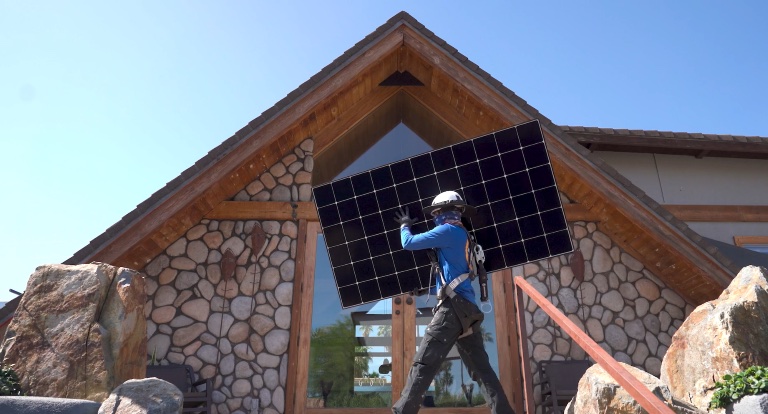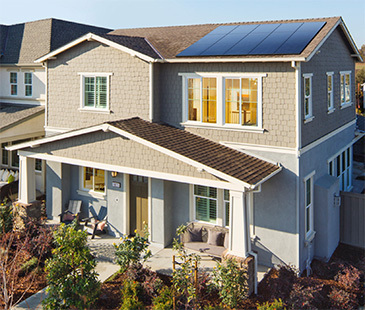
Thanks in part to the Inflation Reduction Act and the additional incentives and rebates available for adopting clean energy solutions, sustainable home renovations are more popular than they’ve ever been. If you’re interested in designing an energy efficient home, there are several ways to go about it but many eco-conscious homeowners are looking into what it takes to go completely net-zero.
What is a net-zero home?
A net-zero home produces the same amount of energy it consumes each year. To achieve net-zero home living, you need to maximize how much energy your home produces and consume it as efficiently as possible. It takes three steps to renovate a home to be net-zero:
1. Get an Energy Audit.
An energy audit is a service in which a trained professional comes to your house to identify areas that could benefit from weatherization, potentially saving you hundreds of dollars a year. An energy audit will help you understand how energy currently flows through your home and where you can make simple updates to maximize energy efficiency.
The Inflation Reduction Act includes up to $1,600 in rebates for weatherization, which is the series of steps you can take to reduce the amount of energy required to heat and cool your home. This may involve air sealing, insulation, door and window upgrades, and ventilation improvements. With severe weather events on the rise, small updates like these can make your home more comfortable and more efficient.
Check with your local utility for tips on how to get an energy audit. Thanks to the Inflation Reduction Act, you can get a $150 tax credit just for performing one.
2. Upgrade to energy efficient appliances.
Energy efficient appliances maximize the energy it takes to run them. Thankfully, there are lots of energy efficient electric appliances on the market today. The Inflation Reduction Act offers incredible tax incentives and rebates for updating appliances to electric, including replacing an HVAC system with a heat pump, or a gas stove with an induction or electric stove.
3. Install solar panels with solar battery storage.
A home cannot be truly net-zero unless it produces its own energy. A well-suited solar system that offsets at least 100% of your energy usage allows you to produce the energy you need to power your home. A trusted SunPower dealer can help you determine how many solar panels you will need to accomplish this. Coupled with a solar battery, you can effectively power your home at any time by utilizing the excess solar energy you stored during the day. There is a 30% tax credit available with the Inflation Reduction Act for both solar systems and solar battery storage.
Over the course of a year, a home’s solar production and energy consumption will fluctuate. There will be days you use more electricity than you produce, and days when you produce more than you use. Solar batteries enable you to either use excess energy to power your home or sell it back to the utility when the grid needs it most. The key to net-zero home living is that energy consumption and production equalize over the course of a year.
Bonus idea: Electric vehicles as increased battery storage.
In the coming years we will see more electric vehicles offer “vehicle-to-home" bidirectional charging, which means the car’s battery will have the ability to provide energy back to the home. SunPower and General Motors are teaming up to develop a new home energy system that does just that, enabling drivers to power their home during blackouts using the battery in their EV.
Net-zero design inspiration
The key to net-zero home design is that any home can become net-zero. Emmy-nominated hosts Bianca and Michael Alexander of Conscious Living, a show about mindful travel and sustainable living on PBS and Amazon Prime, recently upgraded their 1960’s A-frame Palm Springs Home to be net-zero. By utilizing 47 SunPower solar panels and a 26 kwh SunVault storage system, their mid-century home produces the same amount of energy it consumes each year and provides Bianca and Michael with resilience against rolling blackouts along with other environmental and financial benefits.
Bianca and Michael’s net-zero home remodel isn’t just sustainable, but artful too. The conscious couple worked with local designer Laurie Moulton to create a space with eco-friendly artwork, healing crystals, fair trade furnishings, refurbished wood beams and an outdoor entertaining area that takes advantage of the views of the surrounding San Jacinto Mountains. Check out this episode of Conscious Living where they totally transform their home, from conducting an energy audit to installing solar panels and battery storage.

